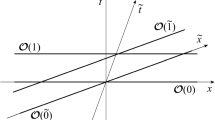Summary
From the unitary representations of the Lorentz transformations two four-vector operators,u μ andU μ, are constructed that satisfy the equationsu μ u μ = −1 andU μ U μ=+1 as operator relations, thus behaving like a timelike and a spacelike velocity, respectively. With the help of one of the Casimir operators (K) of the Lorentz group they are represented by difference operators. Eigenvalues and eigenfunctions for the componentsu 4 andU 4 are derived for spin 0 and 1. In contrast to the case of spin 1/2, in which they could be worked out only in approximation, the solutions for the integral spin values can be given in closed form. At the end, a possible use in particle physics of theK-representation is exhibited by the discussion of a linearized infinite-component wave equation.
Riassunto
Dalle rappresentazioni unitarie delle trasformazioni di Lorentz si costruiscono due operatori quadrivettoriali,u μ eU μ, che soddisfano le equazioniu μ u μ=−1 eU μ U μ=+1 come relazioni operatoriali, comportandosi cosí, rispettivamente, come velocità di tipo tempo e di tipo spazio. Con l'aiuto di uno degli operatori di Casimir (K) del gruppo di Lorentz, essi sono rappresentati da operatori di differenza. Si derivano autovalori e autofunzioni per i componentiu 4 eU 4 per spin 0 e 1. Contrariamente al caso con spin 1/2, nel quale possono essere ottenuti solo approssimativamente, si possono dare le soluzioni per valori di spin interi in forma chiusa. Alla fine, si mostra un possibile uso nella fisica delle particelle della rappresentazioneK mediante la discussione di una equazione d'onda linearizzata a infiniti componenti.
Резюме
Из унитарных представлений Лорентц-преобразований конструируются два четырех-векторных оператораu μ иU μ, которые удовлетворяют уравнениямu μ u μ=−1 иU μ U μ=+1, как операторным соотношениям, и которые ведут себя соответственно как времениподобная и пространственноподобная скорости. С помощью одного из операторов Казимира (K) группы Лорентца эти операторы представляются с помощьу разностных операторов. Для спина 0 и 1 выводятся собственные значения и собственные функции для компонентu 4 иU 4. В противоположность случаю спина половина, где можно получить только приближенные решения, для случая целого спина можно вывести решения в замкнутой форме. В заключение, рассматривается возможное использованиеK-представления в физике частиц.
Similar content being viewed by others
References
In the notation ofJ. D. Bjorken andS. D. Drell:Relativistic Quantum Mechanics (New Yor, N. Y., 1964).
See for that matterW. Wessel andS. J. Czyzak:Phys. Rev.,91, 986 (1953). and the report of the author:Fortschr. Phys.,12, 409 (1964) as well as the work of Bopp and Hönl and others, reviewed byH. Hönl:Ergebn. exact. Naturw.,26, 291 (1952). The point is that a charged particle in interaction with its own field may classically be described by a four-momentum and a four-velocity as independent variables. The latter acts like an inner variable that survives in the system of vanishing momentum.
W. Weissel:Nuovo Cimento,13 A, 248 (1973), to be quoted henceforth as I.
I. T. Grodsky andR. F. Streater:Phys. Rev. Lett.,20, 695 (1968).
A. O. Barut andJ. Nagel:J. Phys. A,10, 1233 (1977).
W. Wessel:Zeits. Phys.,206, 471 (1967).
The author owes this insight to a kind letter ofW. Rühl.
A. O. Barut:Phys. Rev.,135, B 839 (1964).
J. M. Gelfand, R. A. Minlos andZ. Ya. Shapiro:Representations of the Rotation and Lorentz Groups and their Applications (London, 1963).
A. Chakrabarti, M. Levy-Nahas andR. Seneor:Journ. Math. Phys.,9, 1274 (1968).
The general form is [II(σ+iK) II(σ−iK)]1/2 times a polynomial inK. Explicit solutions are givenPhys. Rev.,83, 1031 (1951) and in a condensed, but nonnormalized form in I, formula (2.2).
E. Majorana:Nuovo Cimento,9, 335 (1932).
H. Meschkowski:Differenzengleichungen (Göttingen, 1959).
Author information
Authors and Affiliations
Additional information
Postal address: Am Lechblick 3, 8911 Fuchstal, W. Germany.
Traduzione a cura della Redazione.
Перевебено ребакцией.
Rights and permissions
About this article
Cite this article
Wessel, W. Four-velocities in quantum mechanics and theK-space. Nuov Cim B 44, 337–354 (1978). https://doi.org/10.1007/BF02726797
Received:
Published:
Issue Date:
DOI: https://doi.org/10.1007/BF02726797



